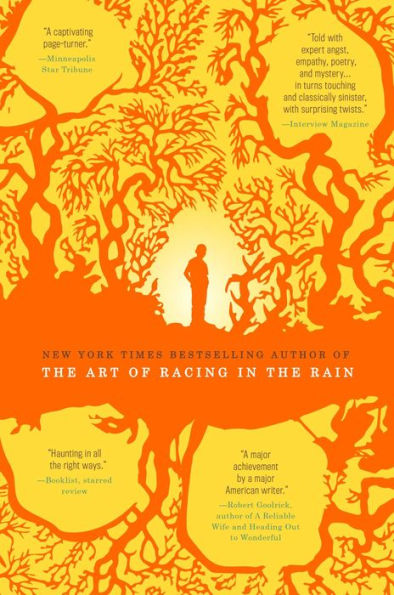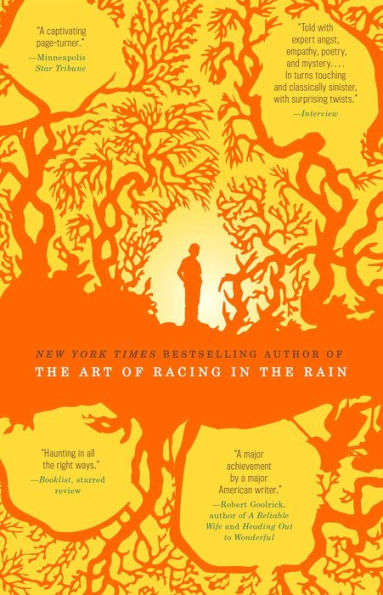Reading Group Guide
This reading group guide for A Sudden Light includes an introduction, discussion questions, ideas for enhancing your book club, and a Q&A with author Garth Stein. The suggested questions are intended to help your reading group find new and interesting angles and topics for your discussion. We hope that these ideas will enrich your conversation and increase your enjoyment of the book.
Introduction
When fourteen-year-old Trevor Riddell and his bankrupt father arrive at Riddell House on Puget Sound, Trevor knows little about his father’s family or the history of the spectacular, decaying mansion. He knows only that his parents have separated and they must convince his grandfather to allow them to sell the house if there is to be any chance of reuniting his parents. But he soon learns that the Riddell family secrets are as numerous as the house’s secret rooms, and that there is something—or someone—in the house with an agenda counter to his father’s. It becomes clear to Trevor that generations of Riddells are in in need of redemption before the family can be lifted from its collective guilt. Trevor may be the only one who can save them and, in turn, save himself from this oppressive cycle.
Topics & Questions for Discussion
1. The novel is narrated by Trevor as an adult looking back on his time at Riddell House. How does his adult point of view shape the narrative? Why do you think the author chose to frame the novel this way? How would it have been different if the story were told from Jones’s perspective?
2. Jones tells Trevor that they are going to Riddell House so they can convince Samuel to sell it. What other reasons does Jones have for returning? What does he really hope will come of their visit?
3. What sort of woman is Serena? Why do you think she never left Riddell House? In what ways does she control the family narrative? What are some of her redemptive qualities?
4. Grandpa Samuel talks about what his wife, Isobel, knew: “If you feel you don’t have enough, you hold on to things. But if you feel you have enough, you let go of things.” Do you agree? What does each character in the novel hold on to and how does it motivate their actions? Who is most willing to let go?
5. A Sudden Light features generations of men. Other than Serena, the women in the story play a relatively minor role yet often have a lasting impact. How did Isobel, Rachel, and Alice influence the men in their lives?
6. Consider the theme of redemption in the novel. What drives Elijah’s and Benjamin’s wish to return The North Estate to its original wild forest? What do they have to atone for? Will returning the land to wilderness redeem them?
7. Why was Benjamin so conflicted during his lifetime? Is his internal conflict a result of his upbringing or education or sexuality? How much of it is a product of the place and time in which he lived?
8. What is the significance of the carving of a hand holding a globe that Harry made for Riddell House? What does the carving symbolize to Benjamin, Isobel, Samuel, Jones, and Trevor?
9. The “eternal groaning” is one of the characteristics of Riddell House. How are Riddell House and The North Estate used as characters in the novel?
10. The beauty and power of nature deeply move Benjamin and Trevor. What do they experience while climbing the great tree near Riddell House? How is Trevor transformed by the climb? Have you felt something similar in nature?
11. Trevor tells Dickie that he chooses truth over loyalty. Do you think seeking answers makes Trevor disloyal to his family? When Trevor reveals what he has learned to his father, what happens?
12. How does the author’s portrayal of ghosts and spirits differ from other ghost stories you’ve read? Did the distinction of ghosts versus spirits make sense to you? Why were Trevor and Samuel the only ones who could see the ghosts?
13. In what way was Jones’s death an act of love? How was it a promise he had to fulfill?
14. Elijah Riddell wrote: “no man is beyond redemption as long as he acts in redeemable ways” and Ben wrote: “It is not prayer, but in deeds that we find absolution.” What burdens have Elijah, Ben, Samuel, Jones, Serena, and Trevor each carried? Was each a permanent obstacle to success in life? Were the characters able to change their fates?
15. What does “faith” mean in the context of this novel? Are faith and belief the same thing? How would you answer the question: “How do we reconcile the differences between what we see and what we know?”
Enhance Your Book Club
1. The writings of John Muir play a key part in A Sudden Light. Research John Muir’s life and read some of his works. Discuss the influence Muir had on Benjamin and on this novel.
2. Choose an outdoor setting—such as a member’s backyard, a local park, or a restaurant patio—for your book club meeting in which to discuss A Sudden Light.
3. If there a mansion or estate in your area that is open to the public, consider touring it with your group and learning about the history of the house and those who built it. What would the land have looked like before it was developed? What impact did the house’s owner have on your local area?
A Conversation with Garth Stein
What inspired you to write A Sudden Light?
I originally wrote about these characters in my play, Brother Jones, which was produced in Los Angeles in 2005—its one and only production. The idea for the play came to me in a dream. Seriously. I had a dream about a house that was alive—haunted by the ghost of a dead ancestor—and communicated with its denizens through creaks and groans. I wrote the play over a hazy few months, working from 9:00 p.m. to 2:00 a.m. while listening to a CD of R.E.M.’s Life’s Rich Pageant set on endless repeat. When I was writing the play, sometimes (usually after midnight) I felt like the characters were standing behind me, talking into my ear. I was afraid to turn around and look.
So the ideas of an old house, ancestral spirits, timber, and assisted suicide collided in my dream. And when that sort of thing happens, a writer has to start taking notes.
How do the play and the novel differ?
Theater is about the immediacy of drama—the now of drama. Whatever the baggage of the characters, it’s about the characters interacting on a stage in front of us, and it can be quite explosive and energetic and passionate. With novels, on the other hand, we have time to delve into the history of the drama—how we got to the now.
My play was about a family that had grown dysfunctional over generations. Still, it was about the immediate family—the latest generation. When it was time for me to write a new novel, I wanted to revisit that family, but I wanted to really delve into their history and explore the previous generations. So the novel A Sudden Light is much more expansive in terms of bringing the characters to life, as well as bringing the surroundings of The North Estate to life.
What was your biggest challenge in writing this novel?
My biggest challenge was finding the narrative voice. My story is so large in scope—five generations of a wealthy and influential timber family—it was difficult to find a way to tell the story without it becoming unwieldy. And that’s when Trevor came into the room and I realized that telling the history of the family through the eyes of the youngest member was a great way to unfold the drama.
When I first started writing, I tried to tell the story from fourteen-year-old Trevor’s point of view, with the story unfolding as he discovered things in the house. It almost worked, but I found it difficult to have Trevor wade through volumes and volumes of journals and letters and documents. By adding the lens of Trevor as an adult recalling a summer from his childhood, I was able to create a perspective that a fourteen-year-old could not have had at the time. From Trevor’s adult perspective, he can point us to the specific diaries, journal entries, and letters we need to know to understand his story. In other words, all stories have a narrative point of view—a narrative bias—as does mine. By choosing this narrative path, I was to tell the intimate story of a fourteen-year-old kid who was trying to figure out his place in the world, while also relating the epic story of the Riddell family.
The novel has a significant historical component. How did you prepare to write about Elijah and Benjamin Riddell and the timber industry?
I did quite a bit of reading about the Northwest and the timber industry. It’s a compact history, so I was able to grasp the broad sweeps of it pretty quickly.
I absorbed another historical element a little more organically: I grew up down the hill from The Highlands, a wealthy enclave in North Seattle upon which I based The North Estate. When I was a kid, my father drove our family by the Seattle Golf Club all the time. And I spent my summer days walking the railroad tracks or playing at Boeing Creek, the northern border of The Highlands. The old Boeing mansion loomed over us, perched high on the bluff.
I also did some field research for A Sudden Light—I climbed trees with the help of climbing guru Tim Kovar. Tim uses a minimally invasive rope technique to climb very tall trees. Just recently, he and I climbed an eight-hundred-year-old redwood in California. It’s really a spectacular experience: the physical aspect of being so high in a tree, as well as the spiritual connection a climber develops with the tree as he climbs. The tree, a living organism, reveals its personality as one spends more time in its embrace.
The conflict between industry/development and conservation underpins the novel. Is this something you feel strongly about? How do we balance the need for resources and development with conservation?
I do feel strongly that we have to live thoughtful, considerate lives. This doesn’t mean that development and conservation cannot live together. On the contrary, it means both can thrive as long as each movement is aware and respectful of the other.
The conflict between industry and conservation is intrinsic to our developing civilization, and it certainly was evident in the building of the western United States. To build houses and businesses and cities, we needed wood. Wood was abundant in our forests. One tree—two thousand years old or more—could build many houses. And when the houses and businesses and cities built from this old tree burned down, as they inevitably did (e.g., the great fires in Seattle, San Francisco, and other cities), enterprising people could always find more two-thousand-year old trees to cut down.
But at some point we begin to destroy the very things that make us strong. When that happens, we are faced with the truth: we must moderate our growth and at the same time make a deliberate and considered plan for utilizing our natural resources.
Two men from very wealthy families—one of them a timber family—understood this idea before others did, and they implemented a conservation plan that has provided the public with our much cherished National Parks: Theodore Roosevelt and Gifford Pinchot.
Family relationships, especially father–son relationships, are at the heart of this novel. Why do the Riddells have such difficulty relating to one another?
I think that within our families we have expectations for behavior. We expect that all of our agendas will synchronize and work toward a common goal. But that’s never the case. A son has different ideas from his father. A sister has goals different from her brother. The tension comes, then, when our desire to please our family conflicts with our desire to please ourselves.
I think this is common in families, and most families deal with it in a more or less functional way. The Riddell family, however, is comprised of extreme personalities and extreme desires, so the conflict becomes much more explosive.
You write beautifully about Benjamin and Trevor’s experiences in the forest. Have you experienced something similar? What is your favorite place to spend time outdoors?
I grew up in the Northwest, and spent much time in the woods exploring, riding my bicycle through the back roads of Washington and camping out with a good friend of mine, sailing on Lake Washington, and so forth. So I feel a special attachment to nature, as do most of us who grew up in Pacific Northwest. Things are different now than they were when I was a kid, and the quietude of nature can be more difficult to find. Still, I love walking in the Grand Forest on Bainbridge Island or spending time at the little cabin we have there. I love taking my boys on a hike up to Mount Si or Rattlesnake Ridge or to Denny Creek. And if none of these ideas for getting away work, it’s always good to climb high into a tree!
How much of Trevor’s fourteen-year-old self is based on your own experiences? Did you wish to be a writer when you were a teenager?
Keep in mind that questions like this imply that the writer has a certain level of self-reflection that he probably doesn’t have, or else he wouldn’t be writing books about fictional families with long histories. In other words, Trevor isn’t based on my experiences at all, but at the same time, he’s based entirely on my experiences. I like to think of my young self as inquisitive, clever, good with the timely retort, passionate, honest, and true. I was probably more brash and impulsive, and more annoying than funny. But, yes, I wanted to be a writer when I was a teenager.
Yet this is an important thing to remember: old Trevor is telling the story of young Trevor, and, as we are told in the preface, time and the retelling of stories distort those stories. So in the relating of Trevor’s summer, old Trevor has judiciously edited and crafted the story, no doubt changing some details and compressing some moments for dramatic purposes. Perhaps old Trevor deleted some of young Trevor’s brash and impulsive qualities in order to make young Trevor seem more clever and passionate; maybe old Trevor was able to provide young Trevor with retorts we always wish we could have delivered in the moment, if we had only had thought of them! In my mind, young Trevor spent days and weeks going through old journals for evidence of his family’s history. But in the retelling of the story—through old Trevor’s eyes—we skip all the superfluous stuff and cut to the good stuff; the embellishment of the storyteller is certainly felt.
What is your favorite book with a similar narrative structure to yours: an older person narrating his own childhood?
Two books that I really enjoyed reading—maybe so much that I looked to them for their guidance—are A Prayer for Owen Meany by John Irving, and Heading Out to Wonderful by Robert Goolrick. Both of these employ an adult character relating a story from his youth. In Owen Meany, it’s completely transparent and we are reminded of it throughout; in Wonderful, the structure is suggested in the beginning, but then plays out as a reveal in the end. I chose to straddle both worlds with subtle reminders that the story is being told by adult Trevor, while also allowing the narrative to indulge in young Trevor’s voice at times.
What do you think connects the novels you’ve written? Are there themes or topics you find yourself returning to?
My books all deal with families and characters faced with extreme circumstances. I believe when a person is pushed to his limits—or beyond those limits—his true character is revealed. So Jenna in Raven Stole the Moon, Evan in How Evan Broke His Head and Other Secrets, Denny and Enzo in The Art of Racing in the Rain, and now Trevor and his family in A Sudden Light, all must dig deep to find their inner strength.
Other themes I like to explore are spirituality, redemption, faith, perseverance. I also like to play with magical realism to more or less of a degree. I firmly believe that novels are more powerful if they go beyond a simple representation of the world around us. I believe that novels should be constructed very carefully to provoke thought and emotion in the reader, so I hope that someone who reads one of my novels will ultimately look at the world a little differently.













